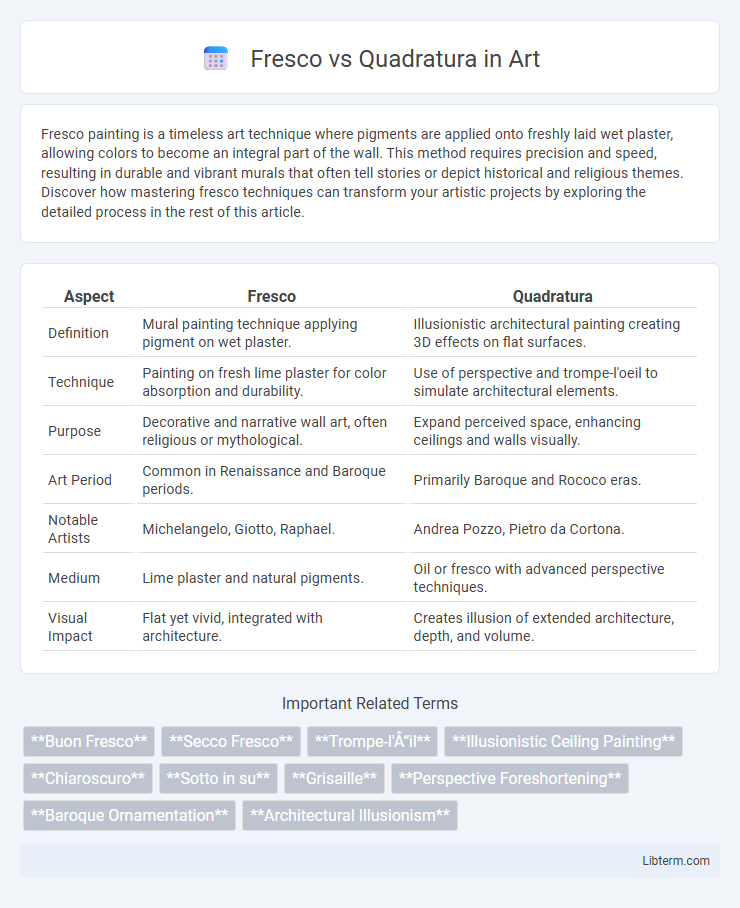Fresco painting is a timeless art technique where pigments are applied onto freshly laid wet plaster, allowing colors to become an integral part of the wall. This method requires precision and speed, resulting in durable and vibrant murals that often tell stories or depict historical and religious themes. Discover how mastering fresco techniques can transform your artistic projects by exploring the detailed process in the rest of this article.
Table of Comparison
| Aspect | Fresco | Quadratura |
|---|---|---|
| Definition | Mural painting technique applying pigment on wet plaster. | Illusionistic architectural painting creating 3D effects on flat surfaces. |
| Technique | Painting on fresh lime plaster for color absorption and durability. | Use of perspective and trompe-l'oeil to simulate architectural elements. |
| Purpose | Decorative and narrative wall art, often religious or mythological. | Expand perceived space, enhancing ceilings and walls visually. |
| Art Period | Common in Renaissance and Baroque periods. | Primarily Baroque and Rococo eras. |
| Notable Artists | Michelangelo, Giotto, Raphael. | Andrea Pozzo, Pietro da Cortona. |
| Medium | Lime plaster and natural pigments. | Oil or fresco with advanced perspective techniques. |
| Visual Impact | Flat yet vivid, integrated with architecture. | Creates illusion of extended architecture, depth, and volume. |
Introduction to Fresco and Quadratura
Fresco is an ancient mural painting technique where pigments are applied on freshly laid lime plaster, allowing the colors to chemically bond with the wall for durability. Quadratura is a baroque painting method that uses perspective and illusion to extend architecture through painted architectural elements, creating a three-dimensional effect on flat surfaces. Both techniques are essential in enhancing interior spaces, with fresco emphasizing durability and color integration, while quadratura focuses on spatial illusion and decorative expansion.
Historical Background of Fresco
Fresco painting traces its origins to ancient civilizations like the Minoans and Egyptians, flourishing notably during the Italian Renaissance with masters such as Michelangelo and Raphael. This technique involves applying pigment onto freshly laid wet plaster, enabling durable and vibrant wall murals integral to architectural decoration. Quadratura, by contrast, evolved later as a Baroque illusionistic style focusing on painted architectural features that extend real space, distinguishing it historically from the more foundational fresco method.
Origins and Evolution of Quadratura
Quadratura originated during the Italian Renaissance as an innovative technique of painted architectural illusions, evolving from the fresco tradition that involved applying pigment onto wet plaster. This 3D trompe-l'oeil method expanded in the Baroque period, enhancing ceiling and wall decorations by creating the illusion of extended architectural space beyond physical confines. Fresco, while foundational, primarily focused on narrative and religious scenes, whereas quadratura specialized in transforming flat surfaces into perceived expansive architecture through advanced perspective techniques.
Key Techniques in Fresco Painting
Fresco painting involves applying pigment onto freshly laid wet lime plaster, allowing the colors to chemically bond with the wall for durability and vibrancy. Key techniques include intonaco, the smooth final plaster layer, where artists paint quickly before it dries, and arriccio, the rough underlayer that provides texture and adherence. Mastery of cartoon transfer, where preparatory drawings are pounced onto the plaster, ensures accuracy in fresco compositions distinct from the illusionistic perspective techniques used in quadratura.
Distinctive Characteristics of Quadratura
Quadratura is distinguished by its use of illusionistic architectural painting that extends real architecture through perspective techniques, creating a three-dimensional appearance on flat surfaces. Unlike traditional fresco, which directly paints on wet plaster emphasizing narrative and figurative elements, quadratura focuses on spatial expansion and the seamless integration of painted architecture with actual architectural features. This technique often incorporates trompe-l'oeil, producing convincing illusions that blur the boundaries between painted and real space.
Artistic Purposes: Illusion vs. Expression
Fresco techniques emphasize artistic expression by using pigments applied on wet plaster, creating vibrant, durable murals that capture emotional depth and narrative detail. Quadratura focuses on illusionistic art by extending architectural space through painted perspectives, tricking the eye to perceive three-dimensional structures on flat surfaces. Both serve distinct artistic purposes: fresco offers expressive storytelling, while quadratura enhances spatial perception through visual illusion.
Famous Artists and Masterpieces
Fresco techniques are exemplified by Michelangelo's monumental Sistine Chapel ceiling and Raphael's School of Athens, showcasing detailed narrative scenes painted on wet plaster for durability and vibrancy. Quadratura, a sophisticated form of trompe-l'oeil, is masterfully demonstrated in Andrea Pozzo's ceiling frescoes in the Church of Sant'Ignazio, where architectural elements appear three-dimensional through painted illusions. Both styles highlight the genius of Renaissance and Baroque artists in blending architecture with illusionistic painting to enhance spatial perception.
Architectural Integration and Space Enhancement
Fresco painting involves applying pigment onto wet plaster, seamlessly integrating artwork with architectural surfaces to create a unified aesthetic that enhances the spatial perception of walls and ceilings. Quadratura is a specialized technique that uses illusionistic perspective to extend architectural features beyond physical boundaries, transforming flat surfaces into visually dynamic, three-dimensional spaces. Both techniques contribute to spatial enhancement, but while fresco emphasizes surface continuity, quadratura manipulates perspective to expand and redefine architectural environments.
Modern Interpretations and Revivals
Modern interpretations of fresco emphasize durable pigments applied to wet plaster, preserving the classical technique while integrating contemporary themes and abstract art. Quadratura experiences revival through immersive digital projections and trompe-l'oeil ceiling paintings, blending Baroque illusionism with modern architectural spaces. Artists today harness both methods to explore spatial dynamics and cultural narratives, bridging historical craftsmanship with innovative visual storytelling.
Comparing Fresco and Quadratura: Summary
Fresco painting involves applying pigment onto wet plaster, creating durable wall murals with vivid colors integral to the surface, while Quadratura utilizes illusionistic architectural paintings to extend real architecture through perspective techniques. Fresco is a traditional technique prominent in Renaissance art for its long-lasting qualities, whereas Quadratura emerged in Baroque art to enhance spatial perception and dramatic effect on ceilings and walls. Both methods aim to transform interior spaces artistically but differ significantly in technique, purpose, and visual outcome.
Fresco Infographic

 libterm.com
libterm.com